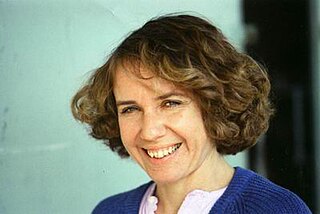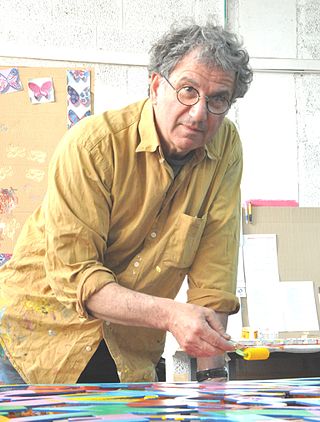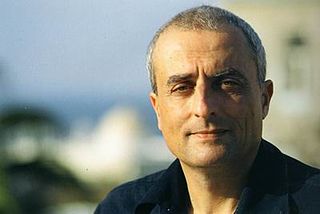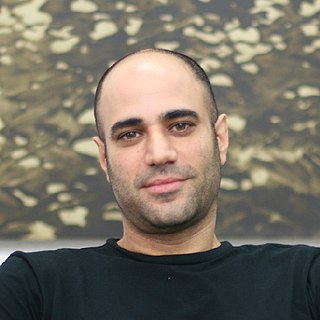Related Research Articles

Avigdor Arikha was a Romanian-born French–Israeli artist, printmaker and art historian.

Pamela Levy (1949–2004) was an Israeli artist.
Avner Ben-Gal is an international painter and artist, working mainly from Tel Aviv, Israel. His works depict various intense, often neglected locations such as agricultural fields, prisons and smoky interiors, whereby theatrical scenes play out. The scenes present ghostly, rough hewn and often low life figures that are bare and hardened. The parallel between Ben-Gal's raw way of painting and his tough, ambiguous subject matter allows a unique intensity within his paintings.

David (Dudu) Gerstein is an Israeli painter, sculptor, draftsman, and printmaker. He began as a figurative painter and was recipient of the Israel Museum Prize for illustration. At the end of the 1970s he wished to expand the limits of two-dimensional painting, into painting in three-dimensions. He began cutting out the main subjects of each painting and to cancel the background, creating a unique and iconic cutout images, free standing in space, without the standard and traditional square frame.

Ofer Lellouche is an Israeli painter, sculptor, etcher and video artist.
Avi Schwartz is an Israeli painter.
Eliahu Gat was an Israeli landscape painter.

Nigel Hall is an English sculptor and a draughtsman.

Joseph (Yossef) Zaritsky was one of the early promoters of modern art in the Land of Israel both during the period of the Yishuv and after the establishment of the State. Regarded as one of the most influential Israeli painters, Zaritsky is known for cofounding the "Ofakim Hadashim" group. In his works, he created a uniquely Israeli style of abstract art. For this work he was awarded the Israel Prize for painting in 1959.
Amnon David Ar is an Israeli painter. He studied at the Arts and Crafts Municipal High School of Tel Aviv until the age of eighteen. After completing his compulsory military service, he studied anatomy with Oswald Adler. He then spent one year at the Bezalel Academy of Arts and Design in Jerusalem, before leaving, because he felt that both the training and the curriculum didn't provide the skills and knowledge he was looking for. For this reason, Ar decided to organize his own studies, and spent a further year learning painting and drawing with Abraham Bykov. By studying with older artists, Ar has trained himself in a traditional way, and can, at least in part, be considered an autodidact. During his studies, Ar worked as a chief illustrator and caricaturist at Maariv and also at Yedioth Tikshoret. Today, Ar also teaches painting and drawing, with the express intention of passing on to the next generation of artists, his experience, and with it his understanding of the artistic skills of the past. In 2014 Ar moved to Berlin, where he has his studio and teaches.
Ori Gersht is an Israeli fine art photographer. He is a professor of photography at the University for the Creative Arts in Rochester, Kent, England.

Larry Abramson is a South African-born Israeli artist.
Christopher Bramham is a painter from Britain.
Hughie O'Donoghue is a British painter.

Khen Shish is an Israeli painter and installation artist.

Miriam Cabessa is an Israeli-American painter, performance and installation artist, winner of the 2022 Israeli Ministry of Culture Lifetime Achievement Award. Cabessa was born in Morocco, raised in Israel, and has lived and worked in New York City since 2000. Her slow action painting has been internationally recognized since 1997 when she represented Israel at the Venice Biennale. Over the past two decades, she has abstained from using brushes, opting to make marks with objects and her body. Her imagery ranges from organic to mechanistic with surfaces that are both haptically handmade and digitally serene. Cabessa has shown extensively in the U.S., Europe, and Israel.

Ruth Schloss was an Israeli painter and illustrator. Major themes in her work were Arabs, transition camps, children and women at eye-level. She expressed an egalitarian, socialist view via realism in her painting and drawing.

Gilad Efrat is a leading contemporary Israeli painter and a professor at the Shenkar College of Engineering and Design, Israel.

Hadar Gad is an Israeli artist.

Moshe Rosenthalis was a Lithuanian-Israeli painter and an art teacher. As a young artist in Lithuania, then part of the Soviet Union, he adapted the dominant Socialist realist discipline. After his immigration to Israel in 1958, where he lived and created for 50 years until his death, he implemented various art methods, including Abstract, Fauvism, Figurative, Expressionism and diverse media and bases. He painted thousands of drawings, portraits, and engravings. His paintings were characterized by vivid colors and Joie de vivre. Many of his works drew inspiration from the Israeli landscapes, images, and peoples, especially of Jaffa Port and Safed.
References
- ↑ Marlborough Fine Art Daniel Enkaoua, exh. cat. (London: Marlborough Fine Art, 1996)
- ↑ "National Portrait Gallery - BP Visitors' Choice
3rd place". Archived from the original on 2010-09-11. - ↑ 'Kunstpaleis met golven voor de deur' in Het Parool, 26 June 2008
- ↑ Ariel P. Hirschfeld, Daniel Enkaoua, exh. cat. (Tel Aviv: Golconda Fine Art, 1998)
- ↑ George Hollander (introduction), Daniel Enkaoua New Paintings exh. cat. (London: Marlborough Fine Art, 2007)
- ↑ Timothy J. Standring (introduction), Daniel Enkaoua New Paintings exh. cat. (London: Marlborough Fine Art, 2009
- ↑ Ariel P. Hirschfeld, Daniel Enkaoua, exh. cat. (Tel Aviv: Golconda Fine Art, 1998)
- ↑ Ariel P. Hirschfeld, Daniel Enkaoua, exh. cat. (Tel Aviv: Golconda Fine Art, 1998)